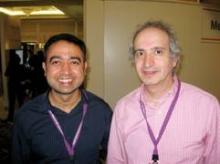ORLANDO – Right unilateral electroconvulsive therapy at six times the seizure threshold is markedly more effective in severely depressed patients aged 60 and older than in those who are younger, according to a multicenter randomized trial.
Bitemporal and right unilateral (RUL) ECT proved similarly effective in older patients, and both were better than bifrontal ECT in the elderly.
"One implication of our study is that in an older patient who didn’t want bitemporal ECT or whose family didn’t, then I would choose right unilateral because it’s just as good," Dr. Sohag N. Sanghani said at the annual meeting of the American Association for Geriatric Psychiatry.
He presented a secondary analysis of a double-blind multicenter trial in which 230 patients with a major unipolar or bipolar depressive episode and a mean baseline score of 35 on the 24-item Hamilton Rating Scale for Depression were randomized to one of the three ECT electrode placements. Remission rates and adverse cognitive effects were similar in all three groups, as previously shown in the primary analysis (Br. J. Psychiatry 2010;196:226-34).
The secondary analysis was aimed at learning if age had a differential effect upon the effectiveness of the three electrode placements. It did: RUL had a 70.4% remission rate in patients aged 60 and older, compared with 46% in the younger group. And bifrontal ECT had a 50% remission rate in older patients versus a 64.4% rate in those younger than age 60, reported Dr. Sanghani, a geriatric psychiatry fellow at Zucker Hillside Hospital in Glen Oaks, N.Y.
In contrast, the 75% remission rate with bitemporal ECT in the older group was not significantly different from the 58.3% rate in younger patients, he added.
Dr. Sanghani’s coinvestigator Dr. Georgios Petrides offered two possible explanations for the differential efficacy with age. One is that because the brain shrinks with advancing age, bifrontal electrode placement in the elderly might result in weak contact and loss of much of the stimulus, while ECT delivered via RUL placement captures much more of the brain.
"On the other hand, we always get a better response with ECT in the elderly than with younger people. So maybe depression in the elderly is a different animal than in younger people," suggested Dr. Petrides, a psychiatrist at Hofstra North Shore-LIJ School of Medicine, Glen Oaks.
Their study was funded by the National Institute of Mental Health. They reported having no relevant financial conflicts.

